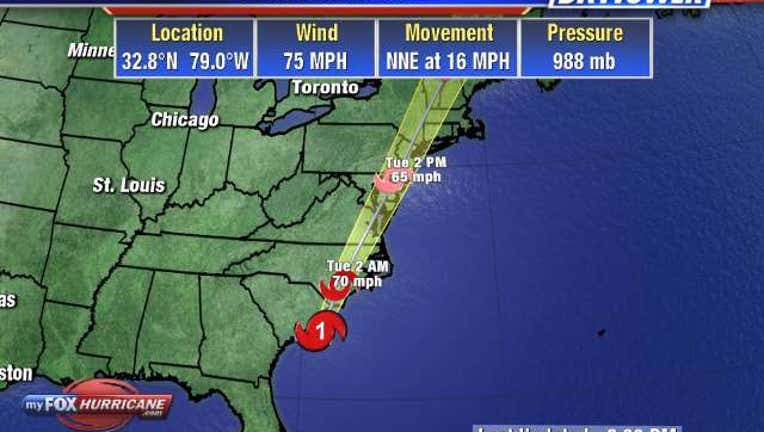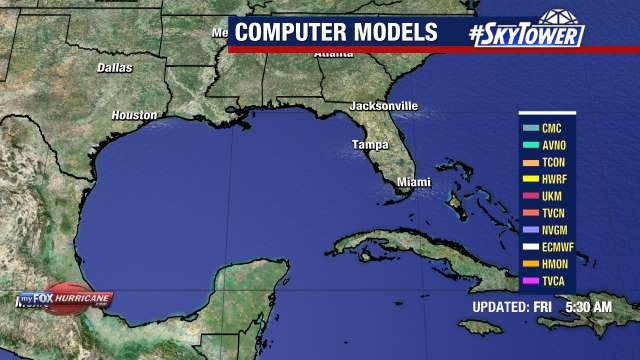Isaias regains hurricane strength as it heads toward Carolinas

VERO BEACH, Fla. - Coastal residents secured patio furniture, ferry operators completed evacuations on the Outer Banks, and officials passed out sandbags and offered car space in elevated garages Monday as Isaias marched northward, forecast to hit the Carolinas as a minimal hurricane.
The U.S. National Hurricane Center warned oceanside home dwellers to brace for storm surge up to 5 feet (1.5 meters) and up to 8 inches (20 centimeters) of rain in spots, as Isaias moves up the coast. The Carolinas weren't the only states at risk.
"All those rains could produce flash flooding across portions of the eastern Carolinas and mid-Atlantic, and even in the northeast U.S.," said Daniel Brown, senior hurricane specialist at the U.S. National Hurricane Center. A tropical storm warning extended all the way up to Maine, where flash flooding was possible in some areas on Wednesday.
Isaias was upgraded again from a tropical storm to a Category 1 hurricane at 8 p.m. EDT. The storm was centered about 60 miles (100 kilometers) south of Myrtle Beach.
Isaias killed two people in the Caribbean and roughed up the Bahamas but remained at sea as it brushed past Florida over the weekend, providing some welcome relief to emergency managers who had to accommodate mask-wearing evacuees in storm shelters. The center of Isaias remained well offshore as it passed Georgia's coast on Monday.
President Donald Trump on Monday described Isaias as "very serious."
"Storm surge and inland flooding are possible and everyone needs to remain vigilant until it passes," Trump said.
Authorities in Myrtle Beach, South Carolina, ordered swimmers out of the water to avoid rough surf and strong rip currents. By sundown, power began to flicker at beachfront hotels as Isaias crossed the last bit of warm water in its path as it headed for the U.S. mainland.
Still, in a part of the South Carolina and North Carolina coast that has been at least brushed by seven tropical storms or hurricanes since 2014, residents weren't panicking about this one.
"It's just going to be a lot of wind and high tide," said Mike Fuller, who has lived along the coast for over a decade.
Shops and restaurants appeared quieter than usual for a summertime Monday in North Myrtle Beach, but locals blamed COVID-19 more than Isaias. No businesses were boarding up their windows, although some moved outside furniture inside.
LINK: Track Isaias on MyFoxHurricane.com
Wayne Stanley and his family came to the city over the weekend from Julian, North Carolina. He's never experienced a hurricane, but said he never considered canceling his family's weeklong vacation either.
"I was pretty scared to start off with," Stanley said Monday. "Then we thought maybe it's not going to be that bad."
Officials in frequently flooded Charleston, South Carolina, handed out sandbags and opened parking garages so residents on the low-lying peninsula could stow their cars above ground.
The center of Isaias passed about 50 miles (80 kilometres) offshore of Charleston on Monday evening. Forecasters warned earlier of possible major flooding, but the storm passed faster than expected and only about a dozen streets were flooded.
Farther up the coast into North Carolina, the hurricane center predicted storm surges of 3 to 5 feet (0.9 to 1.5 meters) when Isaias moves onshore. North Carolina Gov. Roy Cooper warned residents on Monday that the storm could be dangerous regardless of its strength. He urged those evacuating to turn to shelters as a last resort, citing coronavirus risks and the need to operate shelters at reduced capacity to allow for social distancing.
"Whether it's labeled a tropical storm or a hurricane, you should take this storm seriously, and make sure your family is ready," Cooper said.
Ferry operators wrapped up evacuations from Ocracoke Island in North Carolina's Outer Banks on Monday, moving more than 3,500 people and 1,700 vehicles off the island over four days. Island officials were taking no chances after taking a beating less than a year ago from Hurricane Dorian. Evacuation orders also have been issued for Hatteras Island north of Ocracoke.
Morgan Stewart said many evacuating residents had come into the store where she works in the inland community of Kinston to buy tarps, batteries, flashlights and other supplies.
"You can tell they're worried," said Stewart, who saw cars parked on higher ground over the weekend as she secured her boat at a marina. Since forming last week, Isaias has been buffeted by competing forces both trying to kill and strengthen it, said University of Miami hurricane researcher Brian McNoldy.
"Of all the places it could be, it found the warmest water it could," which fuels storm development, McNoldy said. "And yet it is struggling."
That's because dry air kept working its way into the storm at low and mid-levels, which chokes storms.
Isaiah's passage near Florida over the weekend was particularly unwelcome to authorities already dealing with surging coronavirus caseloads. The storm brought heavy rain and flooding to the state, forcing authorities to close outdoor virus testing sights, as well as beaches and parks. Officials lashed signs to palm trees so they wouldn't blow away.
About 150 people had to keep masks on while sheltering in Palm Beach County, which had a voluntary evacuation order for people living in homes that can't withstand dangerous winds, said emergency management spokeswoman Lisa De La Rionda.
Isaias was blamed for two deaths in the Dominican Republic and Puerto Rico, where it uprooted trees, destroyed crops and homes and caused widespread flooding and small landslides over the weekend. The storm snapped trees and knocked out power Saturday in the Bahamas. Shelters were opened on Abaco island to help people still living in temporary structures since Dorian devastated the area, killing at least 70 people in September 2019.
___
Associated Press reporters Russ Bynum in Savannah, Georgia, Jeffrey Collins in Columbia, South Carolina, Wilfredo Lee in Verona Beach, Florida, Danica Coto in San Juan, Puerto Rico, Curt Anderson in St. Petersburg, Florida and Cody Jackson in Palm Beach County, Florida, contributed.


